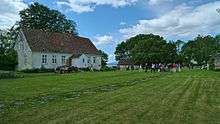Halsnøy Abbey


Halsnøy Abbey was a house of Augustinian Canons located on the island of Halsnøy on the Hardangerfjord in Kvinnherad, Hordaland, Norway, and was one of the richest monasteries in medieval Norway.
The monastery is believed to have been founded in 1163 or 1164 by the jarl Erling Skakke, as an inducement to Archbishop Øystein to crown Erling's seven-year-old son, Magnus Erlingsson, as King of Norway. The new foundation attracted many generous endowments and soon became one of the wealthiest in Norway.
The buildings were severely damaged in a fire about a hundred years later, and were rebuilt in Gothic style about 1300.
The monastery was dissolved in 1536 during the Reformation and its lands and assets were confiscated by the Crown. For over 200 years it was administered as state property, but in 1758 the estate was bought by the chamberlain Andreas Juel, in whose family it remained until 1956. Lt. Andreas Juel, a descendant of the purchaser, demolished the remaining monastic buildings in about 1840 and built a new house from the stone in 1841.
In 1956 the site was bought by the Sunnhordland Museum,[1] who have conserved the building remains. Halsnøy is very unusual among Norwegian monastic sites in that what survives is not the principal monastic buildings (church, chapter house and so on), but the smaller ancillary buildings. These survive on only two other pre-Reformation monastic sites in the country, Selje Abbey in the district of Nordfjord and Hovedøya Abbey in Oslo.
Notes
- ↑ at that date the Sunnhordland Folkemuseum
Sources
- Norges klostre i middelalderen: Halsnøy kloster (Norwegian)
- Sunnhordland Museum: Klostertunet på Halsnøy (Norwegian)
Coordinates: 59°47′49″N 5°39′21″E / 59.79694°N 5.65583°E